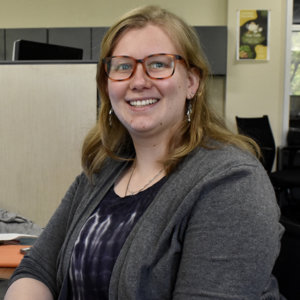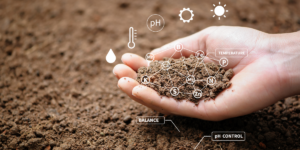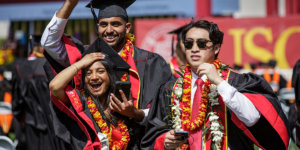
Credit: EnvatoElements
Imagine a city with trees lining every street, safe roads for cyclists, and infrastructure designed specifically for pedestrians to feel secure while walking. A place with clean air and neighbors who help each other.
That’s the vision that USC Viterbi’s Ph.D. candidate Sarah Cooney has for everyone.
With her research focusing on Artificial Intelligence (AI) and Human-Computer interaction (HCI), Cooney created a software system that allows everyday citizens to design their surroundings in order to make them more sustainable.
“The idea is that when we ask people to be more sustainable, we want communities to be resilient in the face of things like COVID, and all the supply chain issues, and think about how you’re really reliant on your local community,” said Cooney. “Things like keeping you healthy with masking, but also, just borrowing supplies or checking in on neighbors.”

Cooney based all of this on the idea that communities can be more resilient and sustainable if the community itself is more accessible, or more “out and about.” Meaning that the streets are walkable and there are outdoor dining options, as well as overall accessibility. A place where people are safe and feel safe with each other.
“What we’re looking at is to see if we can take images of places that are not like that and use artificial intelligence to project an image of what they would be if we change them, or to redesign them in a sense, to make them more people-friendly,” said Cooney.
The project uses an off-the-shelf algorithm called Pix2Pix, and a technique called Style Transfer. The program works by pairing images, before and after pictures, to teach the machine principles of what makes a good city in the United States. Thus, by later inserting a new image, the program should create a realistic output.
Currently, in the design phase, the project is focusing on helping people imagine how things could be different. This would be particularly helpful for people who haven’t lived in a place like this and might have a hard time imagining it, not seeing why it would be beneficial.
“Right now it’s a lot about helping the people imagine how things could be different. A lot of times it’s just hard to even think about, especially if you’re in a place where this isn’t common and you don’t have this kind of access,” said Cooney. “A lot of it is just, you know, helping people see the possibilities. And then ultimately the goal would be to help people implement those possibilities.”
After the design phase is finished, Cooney hopes to change the direction of the project into helping people implement those possibilities. Thus dividing the project into two questions:
“What does this even look like? And then, how can that be made a reality?,” said Cooney.
According to Cooney’s supervisor, Assistant Professor Barath Raghavan, as it currently is, urban design is not accessible for many, which can have negative consequences for everyday people. But Cooney’s work can change that.
“Most people live in urban areas, but the process of changing the landscape is something only a few can do: you have to find out about city meetings, attend them at whatever hours they’re held at, attend over and over to make your voice heard over the course of years, it’s not something that everyone can do, and so some areas have vacant lots or trashed parks,” said Raghavan.
But Cooney’s work can democratize urban planning, and it has the potential to improve the livability and sustainability of urban environments, according to Raghavan.
Cooney’s interest in this process can be traced back to her home, as she spent most of her life in a rural area in Central Pennsylvania, before moving to the Philadelphia area, earning her undergraduate degree from St. Joseph’s University. Her ideal space is a combination of both, a green and accessible place like the one she grew up in but with the possibilities of a city, with all the amenities and cultural opportunities that Cooney had in her academic life.
Despite focusing on math and computer science, Cooney was interested in learning about social sciences after being inspired by her liberal arts undergraduate university, something that has stuck with her during her STEM career.
“I was really interested in how I could use this in a socially good or socially responsible way” she said.
After graduating from St. Joseph’s University, Sarah came to USC choosing to go straight to a Ph.D. program and skip earning a master’s degree, due to the high costs associated. There was also the added bonus that if the Ph.D program didn’t work out she could leave early with a master’s degree. Luckily Sarah didn’t have to resort to her backup plan, as she is graduating in May with a Ph.D.
Here at USC Viterbi, she thrived.
“Sarah is a true scholar, someone who is interested in understanding both social contexts and research approaches at a deep level. Sarah delves deep into the vast troves of knowledge available today and maps out what is known and not known and then articulates novel projects to address those problems,” said her supervisor Raghavan.
Outside of research, Cooney is also interested in education, and she accepted a job as an assistant professor at Villanova University, just outside of Philadelphia.
“I really enjoy teaching. And I think if I could kind of have an influence on the next generation of computer scientists, it would really be impactful to me because I think computer science is everywhere these days, and I think being able to sort of show students the ethical and cultural implications of their work and that it’s not just engineering and science and math, it’s really embedded in our society,” said Cooney.
With the passion to do research that would help others, and a mission to teach others to use their skills to improve the world, Cooney will be doing just that.
Published on April 6th, 2022
Last updated on May 3rd, 2022











